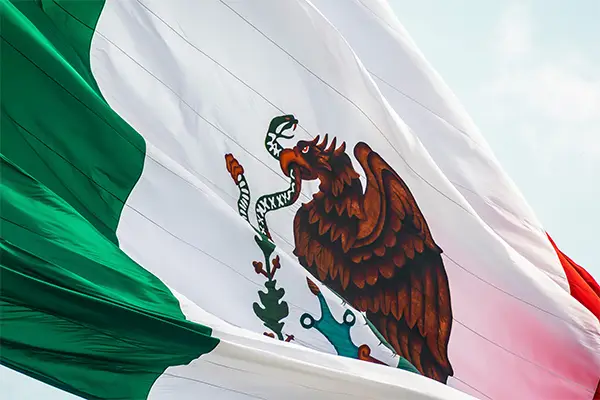Obesity rates and health-related ailments are on the rise, so as of March 2020, the Mexican government and the Official Mexican Standards (NOM) have tightened their regulations when it comes to Mexican nutrition labeling. By providing customers with transparent and informative labeling on food products, these changes can guide consumers toward making healthier dietary choices.
Manufacturers and businesses in the food industry need to update their nutrition labels so that they remain compliant with current regulations. Additionally, these new label formats educate consumers about what exactly is in their food and curb the public health crisis through this transparency. Several companies out there offer sophisticated software that simplifies these regulations and assists businesses that are navigating their way through the maze of nutrition labeling.
TLDR
- Label Varieties: A diverse array of templates exists to suite specific product types, package sizes, and regulatory requirements in Mexico.
- Standard Label: The Mexico Standard Nutrition Facts Label details mandatory nutritional elements like calories, proteins, fats, and more in a clear format.
- Voluntary Nutrients Label: Offers additional nutrient details such as vitamins and minerals, catering to more health-conscious consumers.
- Linear Label: Ideal for products with limited packaging space, displaying mandatory nutritional information in a single horizontal line.
- Dual Column Label: Shows nutritional values for both the unprepared and prepared states of products, useful for items that require additional ingredients to prepare.
- Bilingual Options: All label types to cater to Spanish and English-speaking consumers so that there is fairness and accessibility for both types of customers.
- FOP Warning Labels: Alerts consumers to excessive levels of critical nutrients like sugars and fats, as part of Mexico’s health initiative to combat diet-related issues like obesity.
- Decision-Tree Guide: Our helpful diagram helps businesses determine the best label format for their product and so that their labels remain compliant.
- Create Effective Labels with FLM: Food Label Maker offers an easy-to-use platform that simplifies creating and updating compliant labels, while accommodating regulatory changes effectively.
Mexican Nutrition Templates
Choosing the correct nutrition label for your food package is important for regulatory compliance but is also a way for you to present the correct information to your customers. Navigating the diverse array of templates can be complicated as they each serve a particular purpose and cater to different product types and package sizes. Each template needs to serve its regulatory purpose by promoting transparency and clear information, but it must also cater to different product types and packaging formats. Let’s help you decide which template you should choose for your product.
Mexico Standard Nutrition Facts Label
According to current regulations, the Standard Nutrition Facts Label is the most commonly used and must depict elements such as calories, protein, total fat (made up of trans fat and saturated fat), available carbohydrates, sugar, added sugar, dietary fiber, and sodium. This information must be clearly displayed so that consumers can see the nutritional composition of the food and make more informed dietary choices.
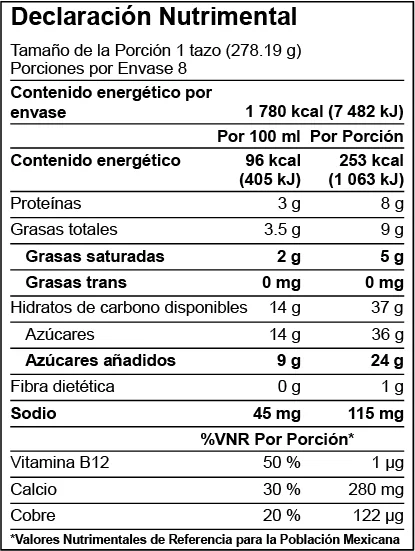
The label can be presented in only Spanish or Spanish-English for bilingual customers, as shown below.
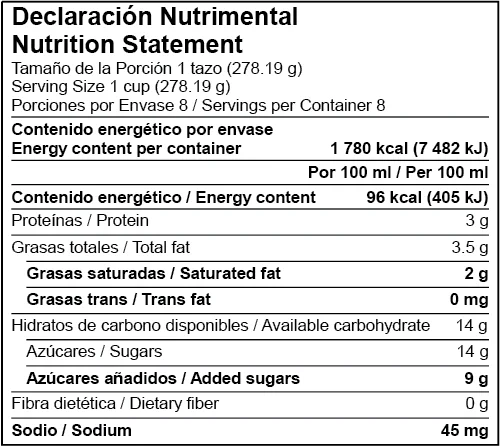
Mexico Standard Nutrition Facts Label with Voluntary Nutrients
This label is slightly more nuanced as it includes all the mandatory information in the standard format but also has added voluntary information and nutrients that manufacturers might want to highlight. This includes nutrients like vitamins and minerals such as Vitamin A, Vitamin B, calcium and iron, dietary fiber, sugars, cholesterol, and certain types of fats. This is helpful for health-conscious customers to see as they are more conscious about particular nutrients or the nutritional benefits of the food they choose to have.
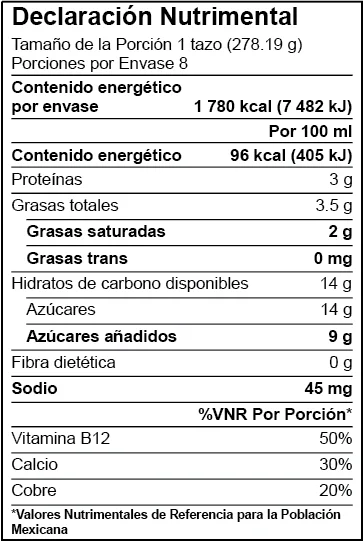
The label can be presented in only Spanish or Spanish-English for bilingual customers, as shown below.
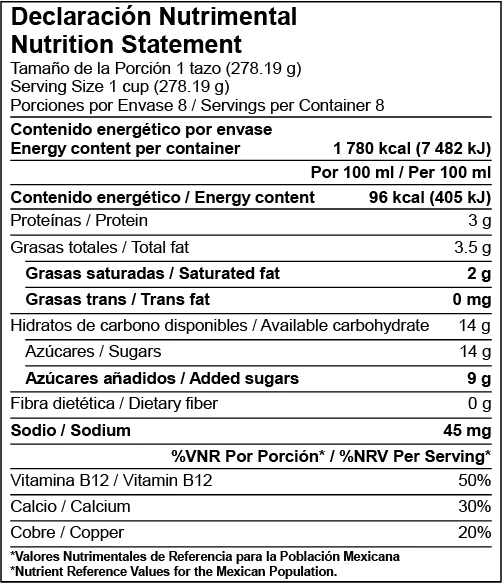
Mexico Linear Nutrition Facts Label
The Linear Nutrition Facts Label is used on products that have limited packaging space. It presents the mandatory nutritional information in a single horizontal line so that it fits the length of the package without missing out or covering up any of the critical nutritional data. This format is ideal for smaller packages where a full-sized label wouldn’t fit. Mandatory nutrition information still needs to be presented on packages no matter what size it is, as customers need to be made aware of what nutrients are in their food and still make informed decisions about their diet by looking at these packages.

The label can be presented in only Spanish or Spanish-English for bilingual customers, as shown below.

Mexico Dual Column Nutrition Facts Label
The Dual Column Nutrition Facts Label is used for foods that can be consumed by 100 mg or mL as opposed to per serving, or by 100 mg or mL as opposed to per container. The two columns detail the nutritional values in both the unprepared and prepared states of the product, providing clarity on how preparation affects the nutritional makeup afterward. An example of this would be cereals that require the addition of milk.
This label depicts the total energy content per container (contenido energetico por envase) in Kcal or kJ. Below it, there are two columns depicting the nutrition facts per 100ml (Por 100ml) as opposed to the facts per portion (Por Porcion).
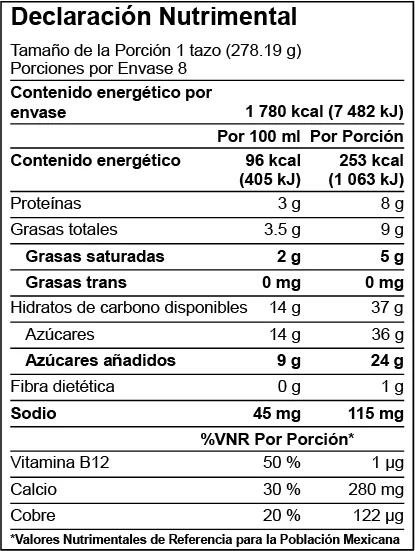
This label depicts the two columns displaying the nutrition facts per 100ml (Por 100ml) as opposed to the facts per container (Por Envase).
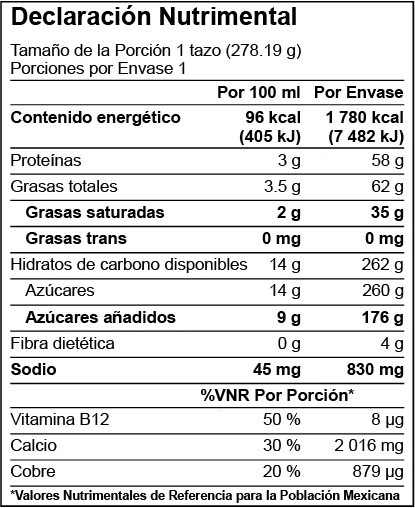
Mexico Front-of-Package (FOP) Warning Labels
The Front-of-Package (FOP) Warning Labels have been introduced under the NOM-051 standard to alert consumers about excessive levels of calories, sugars, sodium, saturated fats, and trans fats in food products. The FOP Warning Label is also applicable to excess amounts of sweeteners and caffeine. This label is part of Mexico’s initiative to combat obesity and other health risks related to consuming excess amounts of these nutrients. By clearly showing that these nutrients are present in a food product through the FOP label, it hopes to encourage healthier eating habits for consumers.

See How FoodLabelMaker Can Help You
Which Format Should You Use?
It can be difficult for businesses in the food and beverage industry to know which nutrition facts labels are best suited to their packages. A decision-tree approach can help you with this process and allow you to follow the best approach for regulatory compliance. Download this pdf for specific Mexican labeling formats.
Easy Compliance
Navigating the complexities of nutrition labeling regulations in Mexico can be challenging, which is why platforms like Food Label Maker (FLM) are the perfect solution for businesses. They offer a user-friendly platform and nutrition labeling software that simplifies this process while ensuring your labels are compliant with relevant regulatory bodies. Users can choose their appropriate label format, customize them according to specific preferences, input data and generate labels that are clear, compliant and consumer-friendly. They also perform regular updates that align with regulatory changes, so you always know that your nutrition labels and products are in safe and efficient hands with Food Label Maker.
FAQs
What are the nutrition label rules in Mexico?
In Mexico, nutrition labels must comprehensively detail mandatory information such as calorie content and the amount of carbohydrates, proteins, fats, sugars, dietary fiber, and sodium in the food product. Labels should also provide this information per serving size and, if necessary, per container. Additionally, any product exceeding recommended limits of calories, sugars, sodium, and saturated fats must include Front-of-Package (FOP) warning labels. Refer to the Official Mexican Standard NOM-051 for a more comprehensive list of regulations and standards that are currently being implemented.
What are the Mexican food warning labels?
Mexican Front-of-Package (FOP) warning labels, or ‘warning octagons,’ are black stop-sign-shaped labels that are placed on the front of food packages. These labels warn consumers if a product contains high levels of ingredients such as calories, added sugars, sodium, and saturated fats, as these are considered detrimental to health if consumed in excess. The FOP warning label is part of the regulatory initiative to have clear and informative labeling on food products to improve consumer health and let people make more informed choices when it comes to their diet.
What are the exceso labels in Mexico?
‘Exceso’ means ‘Excess’ in English, so these labels in Mexico are essentially the same as the FOP warning labels. They indicate that a food or beverage product contains excess amounts of specific nutrients (such as fats, sugars, and sodium) that exceed the recommended thresholds set by Mexican health authorities. These labels are created to alert consumers of potential unhealthy choices.
It is important for businesses to be compliant with Mexico’s nutrition labeling regulations, not just to avoid legal penalties but for the good of your customers. By having clear, transparent, and informative labels on your products, you add to consumer trust and promote a more positive outlook to public health. Understanding and applying these rules can be tricky, but a detailed guide like this simplifies the learning curve. Platforms like Food Label Maker can also help you create compliant labels and get over those regulatory hurdles. Download our comprehensive labeling decision tree or contact us for more personalized assistance.

